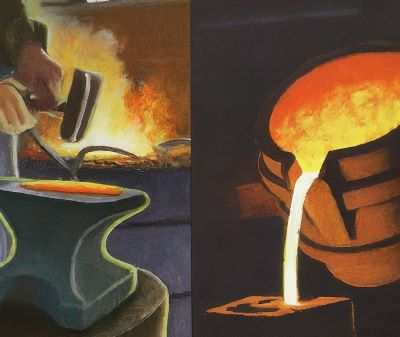The world around us is built on the foundation of strong, reliable metal components. But how do these components take shape? Two of the most important metal forming processes are forging and casting. While both achieve the goal of shaping metal, they do so in fundamentally different ways.
This blog post will serve as a one-stop guide, providing a comprehensive comparison of forging and casting.
What is Forging?
Forging is a metal forming process that utilizes heat and mechanical force to shape metal into desired forms. Here’s a breakdown of the key steps:
➡️ Heating: The metal workpiece is heated to a specific temperature, making it more malleable and easier to shape.
➡️ Shaping: Through hammering, pressing, or rolling, the heated metal is deformed into the desired shape. This can be done using open dies (unrestricted shaping) or closed dies (precise shaping with a mold).
➡️ Cooling: The shaped metal is allowed to cool, locking in its new form.
There are different types of forging, each with its own advantages:
➡️ Open-die forging: Offers greater shaping freedom but with less precise dimensional control.
➡️ Closed-die forging: Utilizes precisely machined dies to create complex shapes with high dimensional accuracy.
➡️ Upset forging: Increases the cross-sectional area of the metal by compressing its length.
What is Casting?
Casting involves melting metal and pouring it into a mold cavity that replicates the desired final shape. Here’s a look at the key steps:
➡️ Melting: The metal is heated in a furnace until it melts into a liquid state.
➡️ Pouring: The molten metal is poured into a pre-prepared mold cavity.
➡️ Solidification: The poured metal cools and solidifies within the mold, taking on the shape of the cavity.
Casting offers a variety of options for creating complex shapes:
➡️ Sand casting: A traditional method using sand molds, suitable for one-off or low-volume production.
➡️ Investment casting: Creates intricate shapes with high surface quality using a wax pattern and ceramic mold shell.
➡️ Die casting: A high-pressure process ideal for mass production of complex, thin-walled parts.
Key Differences Between Forging and Casting
Here’s a breakdown of some key factors that differentiate forging and casting:
A. Strength: Forging generally produces stronger components due to grain flow. The metal grains are elongated and aligned during forging, resulting in superior strength and resistance to fatigue and impact. Castings, on the other hand, can have internal voids or porosity, which can affect strength.
B. Design Flexibility: Casting offers greater flexibility in achieving complex shapes due to the use of molds. Forging is more suited for simpler shapes, although closed-die forging can create some intricate geometries.
C. Material Selection: A wider range of metals can be forged, including steel, aluminum, and titanium. Casting is also suitable for these metals but may have limitations with some alloys due to their melting points or solidification behavior.
D. Additional Processing: Forgings often require some post-processing like machining for final dimensional accuracy. Castings may need minimal machining depending on the casting process used.
E. Cost Considerations: Forging typically has a higher initial setup cost due to the machinery involved. However, the process can be efficient for high-volume production. Casting costs can vary depending on the complexity of the mold. Sand casting is generally less expensive, while investment casting has a higher initial cost due to the mold creation process.
Applications of Forging
Forged parts are preferred in applications where high strength, fatigue resistance, and reliability are critical:
➡️ Crankshafts in engines
➡️ Gears and connecting rods in transmissions
➡️ Aircraft landing gear components
➡️ High-pressure valves and pipes
Applications of Casting
Cast parts are widely used due to their design flexibility and cost-effectiveness:
➡️ Engine blocks and cylinder heads
➡️ Valve bodies and housings
➡️ Complex brackets and levers
➡️ Decorative components and architectural elements
Choosing Between Forging and Casting
The choice between forging and casting depends on your specific needs. Here’s a simplified decision table to guide you:
|
Factor |
Forging |
Casting |
|
Strength Requirement |
High |
Moderate to High |
|
Shape Complexity |
Simpler |
Complex |
|
Production Volume |
High or Low |
High or Low |
|
Budget |
Moderate to High |
Low to High (depending on complexity) |
Note: This is a general guideline, and there can be overlaps depending on the specific application and chosen casting process.
Also read ⬇️⬇️⬇️
PEX Brass Fittings Vs Plastic Fittings: Expert Comparison
Top Tips For Secure Flange To Flange Connection
Conclusion
Forging and casting are both powerful metal forming processes with distinct advantages and limitations. Understanding these differences is crucial for selecting the right process to achieve the desired results.
When high strength and reliability are paramount, forging is the way to go. However, if intricate shapes and cost-effectiveness are your priorities, casting might be the better choice. By considering the factors outlined in this guide, you can make an informed decision and ensure your project gets the best metal forming solution.
Post time: Jun-07-2024


